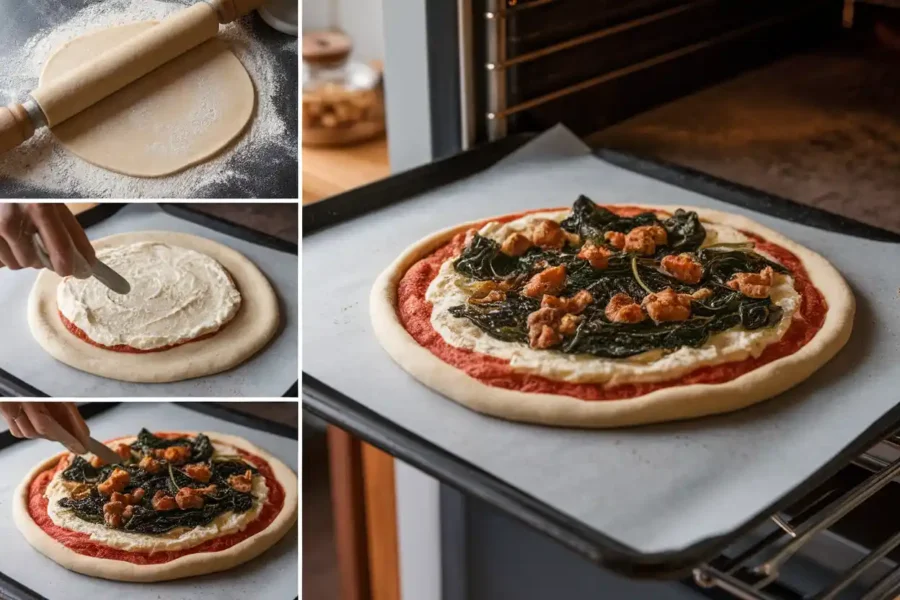Ricotta pizza combines the creamy indulgence of ricotta cheese with a medley of irresistible toppings, creating a pizza that’s both flavorful and versatile. From understanding what makes ricotta the perfect pizza cheese to exploring popular variations, this article takes you on a journey through everything you need to know about this delectable dish. Whether you’re a pizza aficionado or someone looking to elevate your homemade recipes, you’ll find plenty to savor in these insights.
Let’s dive in, starting with an introduction to ricotta pizza and why it’s capturing hearts and taste buds around the world.
Introduction to Ricotta Pizza
What is Ricotta Pizza?
Ricotta pizza is a twist on the traditional pie that uses the creamy, slightly sweet ricotta cheese as a standout ingredient. Unlike mozzarella, ricotta doesn’t melt completely but instead adds a luscious texture that pairs wonderfully with savory toppings. It’s the pizza version of comfort food, offering a rich and velvety bite every time.
The Rise in Popularity of Ricotta Pizza
In recent years, ricotta pizza has soared in popularity, thanks to its presence in gourmet pizzerias and foodie blogs. Its ability to blend with fresh herbs, roasted vegetables, or bold meats has made it a versatile favorite. Home chefs are increasingly turning to ricotta as a way to upgrade their pizza nights, creating combinations that rival restaurant-quality creations.
Why Choose Ricotta for Pizza?
Ricotta cheese isn’t just about flavor it’s also packed with nutrients. A good source of protein and calcium, it’s lighter than other cheeses, making it perfect for those seeking a healthier pizza option. Its creamy consistency complements a variety of pizza toppings, from spinach to caramelized onions, providing endless opportunities to get creative in the kitchen.
Now that we’ve introduced ricotta pizza, it’s time to explore the ingredients that make it shine. Ready to uncover the secrets to a perfect ricotta pizza base? Let’s move on!
The Ingredients That Make Ricotta Pizza Special
The Role of Ricotta Cheese: Texture and Flavor
Ricotta cheese, the star of ricotta pizza, is celebrated for its creamy, slightly grainy texture and mild, slightly sweet flavor. Unlike mozzarella, which melts into gooey strands, ricotta provides a luscious, velvety consistency that adds depth to every bite. Its ability to pair well with savory toppings like spinach or caramelized onions makes it a versatile choice.
Using fresh ricotta is crucial for optimal flavor. Fresh varieties have a brighter taste and creamier consistency, elevating the quality of your pizza. Pro tip: Draining excess moisture from ricotta ensures it doesn’t make the pizza soggy.
Perfect Pizza Dough for Ricotta Toppings
The foundation of any good pizza is its dough. For ricotta pizza, a slightly thicker crust works best, as it can hold the weight of the creamy ricotta and additional toppings without collapsing. Whether you prefer a classic Neapolitan base or a sourdough alternative, ensure the dough is evenly stretched to avoid uneven cooking.
For homemade enthusiasts, incorporating olive oil into the dough can add a hint of richness that complements ricotta’s creamy profile. Don’t forget to let the dough rest it helps achieve that light, airy texture.
Best Pairings: Vegetables, Herbs, and Meats with Ricotta
Ricotta pairs beautifully with a variety of toppings, offering endless creative possibilities. Fresh vegetables like spinach, roasted cherry tomatoes, and artichokes bring vibrant flavors and colors. Herbs such as basil, thyme, and oregano enhance the pizza’s aroma, while meats like prosciutto and sausage add a savory punch.
Combining ricotta cheese with mozzarella or Parmesan creates a multi-layered flavor profile. Add a drizzle of honey or a sprinkle of red pepper flakes for a surprising twist that balances sweetness and spice.
How to Make Ricotta Pizza at Home
Step-by-Step Recipe for Homemade Ricotta Pizza
Making ricotta pizza at home is easier than you think. Start by preparing or purchasing a quality pizza dough. Roll it out onto a floured surface, creating your desired thickness. Preheat your oven to 475°F (245°C) to ensure a crispy crust.
Spread a thin layer of olive oil or garlic-infused oil on the dough, followed by dollops of ricotta cheese. Add your toppings, ensuring even distribution. Bake for 10-12 minutes or until the crust is golden and the toppings are bubbling. Garnish with fresh herbs before serving.

Tips for Preparing the Perfect Ricotta Mixture
For a richer flavor, mix ricotta with a touch of heavy cream, grated Parmesan, or minced garlic. Season with salt, pepper, and a pinch of nutmeg for an aromatic touch. Adjust the consistency by whipping the mixture if you prefer a lighter, fluffier texture.
Avoid overloading the pizza with too many toppings, as it can overshadow the delicate flavor of ricotta cheese. Simplicity is often the key to a balanced, delicious pizza.
Common Mistakes to Avoid When Baking Ricotta Pizza
- Skipping the preheated oven: A hot oven ensures a crispy crust that holds up to the creamy ricotta.
- Overloading the pizza: Too many toppings can make the pizza soggy.
- Using low-quality ricotta: Opt for fresh or artisanal ricotta to enhance the taste and texture.
By following these steps and avoiding common pitfalls, you’ll be able to create a ricotta pizza masterpiece in your own kitchen.
Popular Variations of Ricotta Pizza
Spinach and Ricotta Pizza: A Classic Combination
When it comes to ricotta pizza, the spinach and ricotta pairing is a timeless favorite. The earthy flavor of spinach balances the creamy texture of ricotta, creating a dish that feels both light and indulgent. Adding a sprinkle of garlic or red pepper flakes elevates this classic combination, offering a hint of spice that complements the mild flavors.
To make spinach and ricotta pizza, sauté fresh spinach in olive oil with garlic until just wilted. Spread ricotta over the pizza base, top with the sautéed spinach, and bake until the crust is golden. This simple yet elegant recipe is a perfect introduction to ricotta-based pizzas.
Three-Cheese Ricotta Pizza: A Decadent Treat
For cheese lovers, a three-cheese ricotta pizza is pure bliss. Combining ricotta, mozzarella, and Parmesan creates a medley of flavors and textures that’s hard to resist. The mozzarella offers gooey goodness, the Parmesan provides a sharp bite, and the ricotta ties everything together with its creamy base.
Drizzle the finished pizza with a touch of truffle oil or honey for a gourmet twist. This variation is ideal for entertaining guests or indulging in a luxurious pizza night at home.
Ricotta and Meat Lovers’ Pizza: Perfect for Carnivores
For those who crave heartier flavors, a ricotta and meat lover’s pizza is the way to go. Combining creamy ricotta with spicy sausage, crispy bacon, or thinly sliced prosciutto creates a balanced dish that’s both rich and satisfying.
Layer the meat on top of the ricotta base, ensuring even distribution. Add a handful of caramelized onions or roasted red peppers for a touch of sweetness. The result is a ricotta pizza that delivers bold flavors in every bite.

Ricotta Pizza in Culinary Culture
How Ricotta Pizza is Celebrated Worldwide
From Italy to the United States, ricotta pizza has gained a loyal following. In Italian pizzerias, it’s often featured as a specialty item, paired with fresh, locally sourced ingredients. In the U.S., ricotta-based pizzas have become a gourmet staple, appearing on menus at artisanal pizza joints and upscale restaurants.
The versatility of ricotta allows chefs to experiment with regional flavors, making it a favorite for food enthusiasts everywhere. Whether topped with Mediterranean herbs or spicy jalapeños, ricotta pizza reflects the diverse culinary traditions of the regions it touches.
Local Adaptations: Regional Takes on Ricotta Pizza
Each region adds its unique flair to ricotta pizza. In Mediterranean-inspired recipes, you’ll find toppings like olives, sun-dried tomatoes, and feta alongside ricotta. Meanwhile, New York-style ricotta pizzas emphasize bold, meaty flavors and thicker crusts.
Even home chefs have contributed to its popularity by creating innovative recipes that cater to dietary preferences, such as gluten-free crusts or vegan ricotta alternatives. The ability to adapt makes ricotta pizza a universal dish.
From Gourmet to Fast Food: The Versatility of Ricotta Pizza
What makes ricotta pizza stand out is its flexibility. It can easily transition from a gourmet offering to a quick, casual meal. For a fancy dinner, opt for toppings like truffle oil or smoked salmon. For a weeknight treat, stick with simple ingredients like ricotta, spinach, and mozzarella.
Health Benefits and Nutritional Insights
Nutritional Profile of Ricotta Cheese
Ricotta cheese isn’t just delicious it’s nutritious too. Packed with protein and calcium, it’s a great addition to any pizza for a boost of essential nutrients. Ricotta is also lower in fat than many other cheeses, making it a lighter option without compromising flavor.
Health Benefits of Using Ricotta on Pizza
Using ricotta on pizza offers a healthier alternative to heavy cheeses. Its lower fat content means you can enjoy a creamy topping guilt-free. Additionally, ricotta contains a good dose of vitamin A and B vitamins, supporting eye health and energy metabolism.
Lightening Up Ricotta Pizza for Healthy Eating
For a healthier ricotta pizza, opt for whole-grain or cauliflower crusts to increase fiber. Use low-fat ricotta to reduce calories and add plenty of fresh veggies like spinach, mushrooms, or bell peppers for a nutrient-rich meal.
By balancing the creamy indulgence of ricotta with wholesome ingredients, you can create a pizza that’s both satisfying and nourishing.
Conclusion: Why Ricotta Pizza Should Be Your Next Choice
Summarizing the Versatility of Ricotta Pizza
In the world of pizza, ricotta pizza stands out as a versatile and irresistible choice. Whether you’re creating a simple spinach and ricotta masterpiece or indulging in a decadent three-cheese variation, ricotta’s creamy texture and mild flavor make it the perfect canvas for creativity. Its ability to pair with a variety of ingredients from fresh vegetables to savory meats ensures there’s something for everyone to love.
Ricotta pizza is not only about flavor; it’s also about balance. With the option to incorporate nutritious toppings and lighter crusts, it’s easy to enjoy a pizza that’s both indulgent and health-conscious. No wonder it’s becoming a favorite among home chefs and pizza lovers worldwide.
Encouraging Readers to Try Ricotta Pizza
If you haven’t tried ricotta pizza yet, now is the time. With its endless possibilities and ease of preparation, this pizza is perfect for a casual family dinner or an elegant gathering with friends. Experiment with your favorite toppings, or follow the classic recipes mentioned in this article to start your ricotta pizza journey. Trust us your taste buds will thank you!
FAQs
Is ricotta good on pizza?
Absolutely! Ricotta pizza is loved for its creamy texture and mild flavor that complements a wide range of toppings. Unlike traditional melting cheeses, ricotta stays slightly firm, creating a unique texture that adds depth to each bite. It pairs beautifully with vegetables like spinach and artichokes or proteins such as prosciutto and sausage.
Is ricotta a good melting cheese?
While ricotta doesn’t melt in the same way as mozzarella or cheddar, that’s part of its charm. Instead, it softens and blends seamlessly with other ingredients, creating a rich and velvety texture. This makes it ideal for dolloping onto pizzas where it can maintain its creamy consistency.
What cheese works best on pizza?
Mozzarella remains a classic choice for its melting properties, but when you want to add a touch of creaminess, ricotta is unbeatable. Combining ricotta with other cheeses like Parmesan or provolone creates a flavorful, multi-dimensional pizza experience.
Can ricotta be combined with other cheeses?
Yes! Ricotta is incredibly versatile and works well when combined with other cheeses. Mix it with Parmesan for a savory boost, or add a hint of cream cheese for extra richness. Pairing ricotta with stronger-flavored cheeses like blue cheese can create a bold and indulgent pizza.
Ricotta Pizza Recipe
Ingredients
- For the Dough or use store-bought
- 2 1/4 teaspoons 1 packet active dry yeast
- 1 cup warm water
- 2 1/2 cups all-purpose flour
- 1 teaspoon salt
- 1 tablespoon olive oil
- For the Toppings
- 1 cup ricotta cheese
- 1 cup shredded mozzarella cheese
- 1/4 cup grated Parmesan cheese
- 1 tablespoon olive oil
- 1 teaspoon garlic powder
- 1 teaspoon Italian seasoning
- 1/4 teaspoon red pepper flakes optional
- 1/2 teaspoon salt
- 1/4 teaspoon black pepper
- Fresh basil for garnish
Instructions
- Preheat oven to 475°F (245°C).
- If making homemade dough, dissolve yeast in warm water and let sit for 5 minutes.
- Mix flour, salt, and olive oil with the yeast mixture until a dough forms.
- Knead for 5 minutes, then let rise for 30 minutes (or use store-bought dough).
- Roll out the dough on a floured surface to desired thickness.
- Transfer dough to a pizza stone or baking sheet.
- Spread olive oil over the dough, then evenly spread ricotta cheese.
- Sprinkle mozzarella, Parmesan, garlic powder, Italian seasoning, salt, and pepper.
- Bake for 12-15 minutes, until the crust is golden and cheese is bubbly.
- Remove from the oven and garnish with fresh basil.
- Slice and serve warm.


